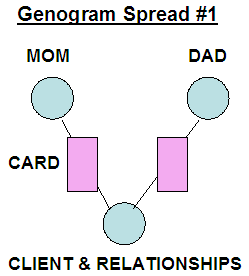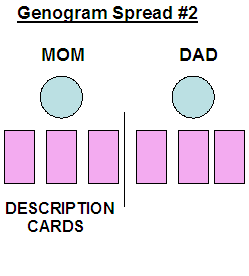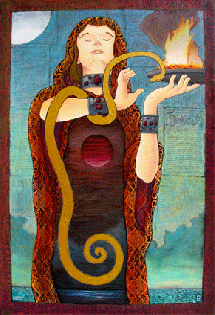Using the Dreaming in ColorTM Deck With Clients
© 2006-2013 Michael Reeder LCPC
Article Purpose
The purpose of this article is to introduce some reasons for using the Dreaming in Color™ deck with psychotherapy clients. It outlines specific ways to use the cards, gives short examples, and discusses appropriate clients to introduce the deck to. It also covers secular therapeutic reasons and methods for the deck’s use, as opposed to the divinatory and more spiritual methods typically used by Tarot readers and followers of metaphysical spiritual paths.
The Dreaming in Colorâ„¢ Deck
The Dreaming in ColorTM deck explores emotional and spiritual states. Each cards is labeled with words that describe emotions like Anger, Depression, Joy; spiritual states like Breakthrough, Awakening, Ascension; and relationship states such as Family, Individuality, and Nurturing. The flower patterns on each card pictorially invoke the word printed on the card. According to the artist, the images “unlock the subconscious mind or Inner Self, allowing the user to reflect and respond with their own imagination and intuition.â€
Some of the images are more obviously linked to the word on their card than others, and some patterns across the pictures can be discerned:
- Strong passions (Anger, Love, Avarice) tend to have strong red hues in the images.
- Cards representing movement from one state of being to another, or representing both a known and a hidden element (Seduction, Lucidity, Learning) tend to include water ponds.
- The haziness or clarity of the image and the size of suns and moons seem to be influenced by the strength and desirability of the states being portrayed. So Aggression has a very harsh sun and Completion a cheery bright sun, while Seduction and Indulgence have very hazy suns, Secrets shows a color veil over the moon, while the moon in Loss is cold and remotely stark.
Words vs. Images
Some clients react more to the word on the card (“I’m angry so I picked the card that says Anger.”), and some more to the image (“I’m one of the smaller, dimmer daisies on the Family card… I’m not smart”). I try to more fully develop the client’s story by asking intuitive questions about the artwork in the cards the client has selected. I make the assumption (and some clients go with it, some not) that everything in the artwork is meaningful to the situation being explored. This may or may not be true, but it helps focus the client on processing the situation at hand. So I might ask my client something like “what’s in the ominous light approaching in the Foreboding card?” or “there’s a color over the moon in the Secrets card—what do you think about that color… how do you feel about that color?” Some clients can gain new insights about their situation by processing their stories from the new unfamiliar angle of relating everything to the cards they have selected.
Populations
Potentially the cards can be used with any client who is open to a pictorial and creative approach. In general I pull the deck out with people needing to become aware of feelings about themselves and their relationships, situations, and spiritual states. In my practice so far, I’ve tended to use them more with clients who:
- Are not especially verbal and are more visually oriented. (Some people seem to relate better to senses other than hearing.)
- Have a poor emotional vocabulary and need to learn terms. (Think of the cards as emotional vocabulary flash cards in this case.) The evocative pictures can help such clients clue in that a card may be important to them even if they are not yet sure what the printed English word means.
- Have low emotional awareness and need options presented to them so they can become aware of the emotional states felt in their bodies.
- Communicate better when engaged in activity (such as sewing and coloring pictures as in one of my past clients). Some people tend to express better through a medium (art, journaling, etc.) rather than telling it directly to the therapist’s face.
- To my initial surprise, they also seem to work well with the mildly retarded, most likely because this is a structured systematic way to discuss feeling and relationship topics—abstract topics that are hard to think about and put into words (they tend to do better within concrete structure).
Using the cards, I can get clients to bring their feelings into awareness and own them. I also can get much information about how they relate to others. I believe that awareness itself is part of healing. In each case, we then discuss why the card was picked and how it feels to them.
Card Spreads
Spreads are limited only by your creativity and the client’s needs. Here are some examples:
- A Self-Reflection Spread: Pick three cards that describe how you feel this week.
- Self-Meditation: This week spend 5 minutes per day reflecting on the card we selected in session (say the Loss card). Take a few deep breaths to quiet yourself (meditation training beforehand might be good). Look at the card for a few moments and allow your mind to focus on anything your eye is drawn to—art images, colors, art style, etc. What do you feel? What memories come up for you? When you are done, journal what you have found.
- Genogram Spread #1: Draw a chart with lines from your name to each family member. Pick one card that describes your relationship with each family member and place it on the proper intersecting line. (This spread is just fabulous for getting lots of family dynamics very quickly.)
- Genogram Spread #2: Pick three cards to represent each of your family members (dad, mom, boyfriend, etc.) and tell why you picked them. (I usually lay out labels for “momâ€, “dadâ€, etc. on the table and let the client place selected cards beneath them.)


A Decision: Random or Chosen Card Draws?
One decision that therapists have to make is whether or not to randomly draw cards. Amongst Tarot readers and the metaphysical community, “random†card draws would usually be considered the work of Higher Guidance—that is, nothing is really chance and the draw of a particular card was purposeful and due to need. This is, however, an assumption that I’m not willing to entertain in the psychotherapy office—especially when explaining my work to supervisors and in peer review! I feel more comfortable letting the client look through the card deck, pick their own cards, and tell me how they are particularly meaningful to them in the moment. I’ve been able to use these cards in medical model therapy settings this way.
Some Jungian analysts do utilize random card draws from Tarot decks, and then assume the cards drawn to be meaningful to the client. In her book Jung and Tarot, Sallie Nichols talks about Tarot cards as archetypes from the collective unconscious or as examples of the Jungian idea of the symbol—“something which can be presented in no other way and whose meaning transcends all specifics and includes many seeming opposites†(pg. 7). In a similar manner, it may be possible to think of all emotional/spiritual states in the Dreaming in Color™ deck as existing in the client’s unconscious and pictured in the artwork in a way that captures the state more fully than words can. So, by this thinking, even if the cards are drawn totally randomly, it’s a useful therapeutic device to assume them to have special meaning in the client’s life. By assuming this, the client can tap into how unconscious forces are at play in the situation being discussed and gain conscious awareness of how he or she is manifesting or relating to the states pictured.
Another way of looking at random card draws is that they force a creative re-examination of the counseling issues from a new angle, thereby breaking old thinking patterns and allowing new insights to emerge. The conscious mind, as a meaning-making engine, is very good at taking inputs (even random ones) and finding a way to meaningfully relate them to real life situations.
Case Example
I’ve changed the names and some details in the case below to protect identities.
Beth was a young woman I saw for, among other things, depression and social skills/assertiveness assistance. She was mildly retarded and especially concerned with turbulent social relationships with her family and friends. When asked how she was doing or getting along with her boyfriend, she was prone to respond “good†or “bad†and stay silent otherwise. I used the Dreaming in Color™ deck to improve her emotional vocabulary, increase her awareness of her individual emotional states and feelings towards family, and help her to share more in therapy sessions.
After being told everything was “good†one week, I asked Beth to tell me how she was doing this week by picking 2-3 cards from the deck. It was slow going, as she asked me for vocabulary definitions every few cards. At first I thought I’d made a mistake introducing the exercise. However, she proved able to learn definitions, and I realized the value in and of itself of vocabulary training. This became a regular drill each week as she was able to open up far more using the cards than through straight speech. She’d usually only make it through half or a third of the deck, but no problem as I’d still learn that she was feeling the “Loss†of a deceased relative or clinging to the belief that he went to Heaven (Breakthrough card). I was then able to engage her through other therapeutic techniques to help with emotional catharsis, or social skills training, or (as in the weekly example just given) grief counseling.
She also possessed an oddly sharp and intuitive ability to look at the pictures on the cards and find a way they related to her situation. So I could ask questions about selected cards like “which daisy are you in the Family card?†or “why is the sun bright on that card?†and half the time get a meaningful response that deepened our understanding.
I tried Genogram Spread #1 above with her. I asked her to list out her most important relationships. She picked her mother, her brother, her sister, and her niece. At my prompting, we also added her ex-boyfriend, current boyfriend, and herself. The cards picked were:
- Mom = Hope
- Sister = Ascension
- Brother = Family & Reaping
- Niece = Breakthrough
- Ex-Boyfriend = Hate
- Current Boyfriend = Passion
- Herself = Learning
Through discussion of cards like Hope, Ascension, Breakthrough, and Family, I learned that she saw her family relationships as generally improving from a troubled past. Her brother (Family) was especially close to her, and he was buying her a cell phone (hence she was “reaping†cool stuff!). She had previously only admitted to “not wanting to be with†her former boyfriend. The selection of the Hate card allowed her to own a hidden feeling. The Hate card led in turn to a discussion on taking the time to experience feelings, that feelings are okay, and how she seems to race into new relationships before being emotionally done with old ones. Through the Learning card, I found out she’d started a new class at her day program.
With this particular client, I simply would never have accessed this material without a structured system like the Dreaming in Colorâ„¢ cards for her to work through.
Links for more information:
The Dreaming In ColorTM Official Website
A very different write-up on the deck from the perspective of psychic readers



